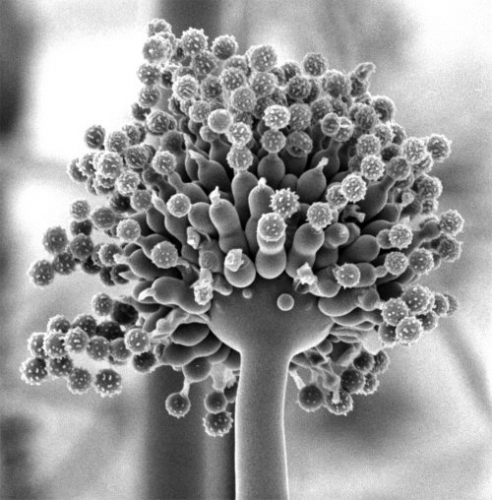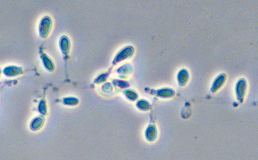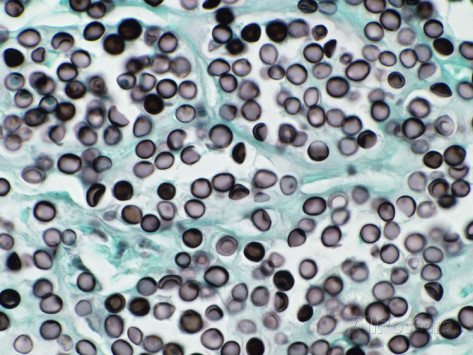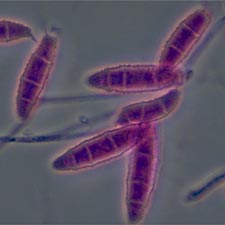| Aspergillus fumigatus | ||
 click for details |
This mold thrives in high temperatures, plenty of oxygen, and low water availability. Its spores are ubiquitous and commonly found in soil habitats, construction areas, stored grain, decaying vegetation, indoor air and dusty environments. These spores have resistance to such warm condition so they can also survive in soil during droughts. This characterstic makes it warm blooded animals pathogen. It enters into the body by inhalation and causes infections in any type of tissue, including brain, but the lungs are where it is most common. | |
| Aspergillus niger | ||
 click for details |
A. niger, the black mold is a filamentous fungus mostly found on decaying plant materials, soil, icy grounds, marine and indoor enviroments. It plays important role in degradation and recycling of dead plant elements. It is both pathogenic and economically important fungus. As a pathogen it commonly causes ear and lungs infection in human and birds. It transmits into humans by inhalation of airborne conidia. As a economically important fungus, it plays a significant role for the industrial production of citric and gluconic acids, ?-amylase and glucose oxidase and many other enzymes. | |
| Candida albicans | ||
 click for details |
C. albicans is a encapsulated, diploid and polymorphic fungus. Two main morphologies are well recognized, one is budding unicellular yeast form and second is filamentous hyphal form. Many cell shape morphologies are there in between these forms termed as 'pseudohyphae'. It is an opportunistic pathogen which lives in the mucous membranes of the human mouth and intestine as a part of gut flora, vaginal tract, skin and other mucus membranes. When its population goes beyond to control due to the weak immune system, it weakens the intestinal wall, penetrates through into the bloodstream and releases toxic byproducts throughout the body. | |
| Chrysosporium tropicum | ||
 click for details |
C. tropicum is a potent keratinophilic filamentous fungus that uses keratin as a substrate for its degradation. Animal hair, poultry feathers, wools, horns, hoofs, nails, cornified epridermis are the major sources of keratin. This fungus is found mainly in soil, plant material, dung, and bird feathers. It works both as important (a keratinophilic saprophyte ) and pathogenic fungus. It degrades various unsoluable keratinous waste into soluable low molecular weight components. It not only degrades the wastes hairs etc. but also a reason of hair loss in humans. | |
| Lacazia loboi | ||
 click for details |
L. loboi is an uncultivated fungal pathogen of humans and dolphins. It is connected by its tubules within the tissue of infected organism. L. loboi thrives in aquatic environment and survive on the dying or decaying materials. The fungus mainly infects cutaneous and subcutaneous skin by developing parakeloidal lesions near cooler areas of the body. It kills the cells of the skin and feed off of that to grow and spread. The biological and epidemiological characterstics of L. Loboi remain unknown due to its strong resistance to in vitro cultivation. | |
| Microsporum ferrugineum | ||
 click for details |
M. ferrugineum is a slow growing, strictly anthropophilic dermatophyte. It generally does not form microconidia and occasionally produces macroconidia in its life cycle. It has a morphology of highly segmented, long, straight and bamboo-like thick walled hyphae. Its only known reservoir is human, mostly children. It causes infections of hairs, nails and skin. Transmission of the dermatophytes can occur via person-to-person contact, and health care workers unknowingly may spread the disease, or it can be transmitted from an infected animal to a person | |
| Microsporum gypseum | ||
 click for details |
M. gypseum is a geophilic dermatophyte and oppurtunistic pathogen. This species of Microsporum relatively grows faster. Its colony is look like powdary to granulary. Color of the colony beige to cinnamon brown. From the reverse, it is yellow to brownish red. It is isolated from the soil or aqueous soil. It causes diseases rarely in humans, depending upon the patients immune power that resist against the infectious agents. | |
| Trichophyton rubrum | ||
 click for details |
Trichophyton rubrum is a cosmopoliton anthroppphilic mold fungus. It grows from slow to moderately rapid. It is downy to cottony like morphology with white color surface. From the reverse it is in wine red color. It can be isolated from tropical areas, soil, humans and animals. It generally not infect animals. But in human it plays a major role in dermatophyte infections. It affects mainly on feet, skin, nails and hairs. | |

